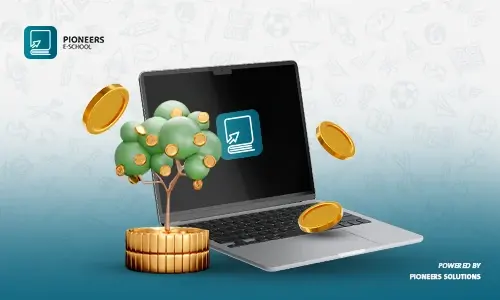Private schools face significant challenges in managing their finances, such as tracking revenues and expenses and organizing financial statements accurately. Fortunately, there are advanced technological solutions that facilitate this process. He promises Pioneers E-School system One of these solutions provides integrated management of financial accounts in private schools.
What is Pioneers E-School?
Pioneers E-School It is an integrated school management system It is considered one of the best programs for managing school accounts. that aims to improve administrative and academic efficiency. The system provides tools that help manage daily operations, such as student registration, lesson management, and academic performance evaluation, in addition to providing accurate financial reports.
The importance of the chart of accounts for private schools
Considered a Chart of accounts An essential part of any private school because it provides precise regulation of financial transactions. Here are some reasons why schools need an organized chart of accounts:
-
Track income and expenses: Facilitating financial planning and analyzing financial performance.
-
Legal compliance: Providing accurate financial reports to government agencies.
-
Financial performance analysis: Identifying areas to improve the school’s financial performance.
Benefits of using a chart of accounts in the Pioneers E-School system
The system provides many accounting and administrative benefits, including:
-
Accuracy and transparency of financial statements: Record transactions quickly and reduce errors.
-
Real-time financial reports: Enables management to make informed decisions based on accurate data.
-
Improving financial control: Reducing the chances of financial errors or fraud.
-
A comprehensive view of the financial situation: Helps monitor and analyze all financial activities of the school.
Basic steps to set up a chart of accounts in the Pioneers E-School system
numbers Tree of accounts It is a process that requires careful organization. Pioneers E-School provides tools that facilitate this process. Here are the basic steps for setting up a chart of accounts:
-
Classification of financial accounts: Organizing accounts according to revenues, expenses, assets and liabilities.
-
Record daily entries: Accurately recording financial transactions.
-
Managing disbursement and receivable permissions: Controlling and documenting financial operations.
-
Determine cost centers: Track costs related to each activity.
-
Determine financial periods: Customize the fiscal year and adjust settings.
-
Bank and treasury management: Linking bank accounts and safes to track financial movements.
-
Preparing various financial reports: Providing comprehensive reports that help analyze financial performance.
The importance of periodically reviewing the chart of accounts
Periodic review ensures that the chart of accounts operates effectively and accurately. Here are some reasons why regular review is vital:
-
Ensure accuracy and reliability: Detecting errors and enhancing the reliability of financial reports.
-
Financial performance analysis: Evaluating financial performance and determining financial trends.
-
Compliance with accounting standards: Ensure compliance with accounting standards and laws.
-
Improving administrative efficiency: Providing accurate information that helps in making better decisions.
Improving administrative efficiency and future planning
By periodically reviewing the chart of accounts, schools can anticipate future financial challenges and develop strategies to deal with them. This improves strategic planning and provides accurate data that supports informed decision-making.
numbers Comprehensive tree of accounts And conduct periodic reviews of the system Pioneers E-School Enhances the efficiency of financial operations in private schools. Schools can make more accurate financial decisions and achieve greater transparency and accountability in managing their resources.
Classification of the Chart of Accounts in Pioneers E-School System
The Chart of Accounts is divided into several key categories that help organize and track the school's financial activities accurately and efficiently. By classifying accounts, management can clearly monitor revenues, expenses, assets, and liabilities. Here's a detailed breakdown:
1. Assets
Assets represent the school's owned properties and are divided into:
- Fixed Assets: These include long-term properties such as:
- Land
- Buildings
- Vehicles
- Furniture
- Current Assets: These are assets that change over the financial year, such as:
- Banks
- Receivables
- Inventory
- Debtors
2. Liabilities
Liabilities represent the debts and obligations the school must settle, including:
- Accounts Payable
- Accrued Liabilities
- Taxes Payable
- Wages Payable
- Bonds Payable
3. Equity
Equity includes the capital invested in the school along with retained earnings, and it consists of:
- Capital
- Personal Withdrawals
- Current Account of the School Owner
- Reserves
- Retained Earnings
4. Revenues
Revenues represent the income generated by the school from its various activities:
- Income and Revenues
- Sales Proceeds, Returns, and Discounts
5. Expenses
Expenses are the costs incurred by the school, including:
- Depreciation Expenses
- Payroll Tax Expenses
- Supplier Expenses
- Wage Expenses
- Service Expenses
- Other Expenses
The expense item can be arranged in the chart of accounts as follows:
Cost of Sales
These include expenses related to purchasing and selling processes, such as:
- Purchases
- Purchase Expenses
- Purchase Returns
- Discounts on Purchases
Sales and Marketing Expenses
These are expenses associated with promotional and sales activities:
- Advertising and Marketing Expenses
Administrative and General Expenses
These include expenses related to the management of the school and general services, such as:
- Salaries
- Maintenance
- Telephones
- Internet
- Electricity
This classification of the Chart of Accounts allows schools to manage their financial resources more efficiently and provides a clear view of their financial performance.
Comprehensive Management of School Accounts with Pioneers E-School
Pioneers E-School offers a professional solution for organizing the chart of accounts in private schools, providing you with a fully integrated and carefully categorized chart of accounts that includes assets, liabilities, equity, expenses, and revenues. With this system, you can have complete control over your accounts, whether they are main or subsidiary accounts, and easily make adjustments, delete, or add internal levels. Additionally, you can link accounts to any branch of the school, determine whether the account is debit or credit, and direct the accounts to appear in the balance sheet or income statement. As a school owner, the program provides you with a comprehensive view of the profits and losses of all your branches at once, allowing you to manage your institution with accuracy and transparency.
In the end, it is considered Managing and organizing school accounts Through a program Pioneers E-School A decisive step towards enhancing financial and administrative efficiency. Using this system, schools can easily track all financial transactions, ensure compliance with legal standards, and improve decision-making based on accurate real-time reporting. Whether you're looking to enhance transparency or improve financial planning, this software is the perfect solution for your school.
Don't miss the opportunity! Contact us today to request your free trial of Pioneers E-School Enjoy easier and more efficient financial management.

Related Articles

2025-02-04
Mohamed Abdelsalam
How the Electronic System Facilitates Communication Between the School and Parents?
Effective communication between the school and parents is a vital element for the success of the educational process. When there is good communication...





